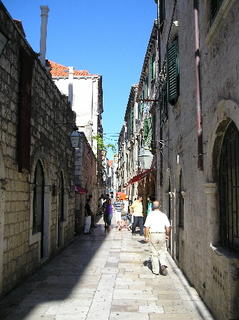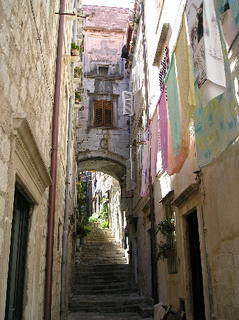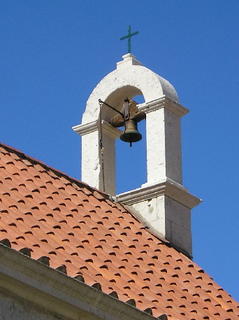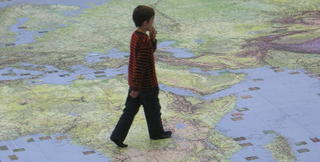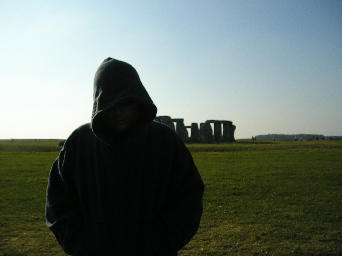
Saturday, October 29, 2005
Wednesday, October 26, 2005
A note about comments
I love your comments! Unfortunately, some mean people have set up a spam comment thing where they post totally stupid ads in comment spaces. So, I'm turning on the 'word verification' feature of the comment process.
More information is here.
I hope it's not a pain. If it is, let me know and I'll remove it.
Enjoy!
More information is here.
I hope it's not a pain. If it is, let me know and I'll remove it.
Enjoy!
Wednesday
Ah...half term...you gotta love it! Since I have an entire week off, I decided to only go in to work one day this week (and that was to work on my teacher qualification portfolio).
Today, though, I went to Parliament! I got to wait in a huge long queue and then I got a full-body pat-down...twice! I saw debates in both the House of Commons and the House of Lords. It was rather interesting!
I'll hopefully have more to post later.
Today, though, I went to Parliament! I got to wait in a huge long queue and then I got a full-body pat-down...twice! I saw debates in both the House of Commons and the House of Lords. It was rather interesting!
I'll hopefully have more to post later.
Visions

The new Libera CD called Visions arrived at my house yesterday. It's really, really good. (Gee, how's that for a learned review?)
Not released in your country yet? You could always order it from Japan or go to their site to have a quick listen before it's available near you.
New Pictures!
You may be noticing that The House of Tomorrow is taking until tomorrow to load. Sorry about that. I have added three new posts with pidtures from my trip to Croatia in August. There are loads more pictures yet to come, but these should be enough to get you started. On most of them, you get a larger picture if you click. On a few, you get a really large picture when you click! Enjoy!
Croatia

More than any other place I have ever been, Croatia looks like the postcards. Rather than spend a week saying, ‘Gee, I wonder where they managed to get the pictures of this place,’ I spent a week saying, ‘Wow! This looks just like it’s supposed to!’
So, where is it?
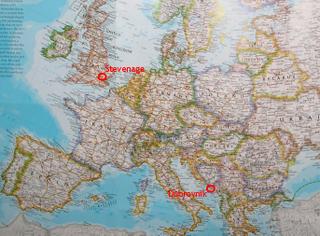
Croatia is along the Adriatic Sea, across from Italy. On a map, it looks like a sideways V, almost like an oddly shaped Pac-Man eating Bosnia and Herzegovina. Dubrovnik is located almost at the very bottom tip of Croatia. (In fact, on the map above, it very nearly looks like it is in either Bosnia and Herzegovina or Serbia and Montenegro. In this part of Croatia, the country is only about 6 km wide.)
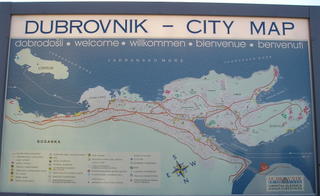
(Careful! In this map, north is down and to the right.)
Dubrovnik is a beautiful city along the sea. It has a walled Old Town and a port, reminders of Dubrovnik’s maritime past, particularly in the 15th and 16th centuries.

I have divided my pictures into several categories, mainly to help organize things. This first post will be a hodgepodge of things.
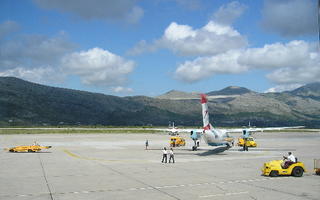
Approaching the Dubrovnik airport, we flew southeast over the water and then turned 180 degrees and landed near these mountains. According to my taxi driver, the mountains used to be covered with trees, but, between the war and forest fires, the mountains remain rather bare and rocky.
I suppose that here I should mention some about the war. It’s always risky when I try to talk about history because there is so much I don’t understand, but I’ll try. Of course, since this is the Balkans, there are probably very few people who understand it all.
Okay…from what I understand, at various times in its history, Croatia has been independent (indeed, it was once a rather formidable naval power), part of other countries, and held under siege. Following World War II, Croatia became the semi-autonomous Republic of Croatia within Federal Yugoslavia, ruled by Tito until the collapse of Communism. In 1991 a referendum was held and voters chose to have a sovereign Croatia stats. Serbia, however, wanted a united Yugoslavia and the United States refused to recognize Croatian independence. On October 1, 1991, the Yugoslav army began its attack on Dubrovnik. The army first destroyed the airport at Cilipi (the Dubrovnik airport is actually about 30 minutes from Dubrovnik, in a place called Cilipi) and the main Dubrovnik port of Gruz.
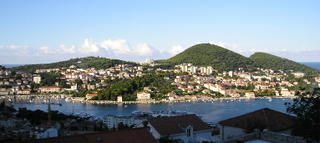
The Yugoslav army then turned their destruction towards the buildings in and around the Old Town. It was only in the latter part of 1992 that Germany, followed by the EU as a whole, recognized Croatian independence.
Today, most of the destroyed buildings in Dubrovnik seem to have been either repaired or rebuilt, although traces of the shelling still remain.

This parking lot not only serves as a place to keep cars, but many of the local children use it to play football (soccer). It is only upon closer inspection that you can see the distinctive star-burst shape that indicates where a shell landed.

Upon arriving at the Dubrovnik airport, I took a taxi to the city. My taxi driver was quite eager to point out the interesting sights and things along the way. The trip followed the curves of the coastline and was very beautiful.

I was able to catch glimpses of Dubrovnik through the trees.
I was staying at a hostel so my driver dropped me off at the hostel office. Then, several of us piled into an old car with a strange man. (Yeah, not really my best travel advice.) But, luckily, after some curving up and around, we ended up at ‘Vila Banana.’ (Really.) The strange man turned out to be Mladen, who, along with his wife (um…Mrs. Mladen, I suppose), own the house (‘My house!’ he kept reminding us proudly.)
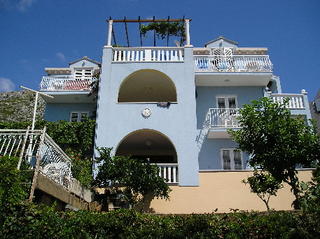
Vila Banana happens to be the only blue house (‘My house!’) in Dubrovnik (at least as far as I could tell), which happens to be a great way to find it again.
After checking in (‘My house!’), I decided to wander around.
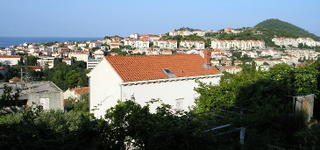
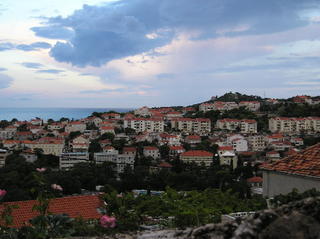
This was the view from the road outside the hostel. Isn’t it beautiful? It was also my second clue (the first was the drive there) to all the steps I would climb that week.
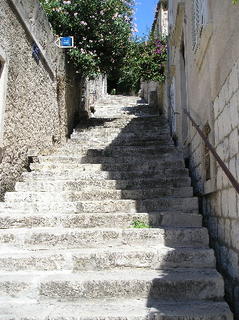
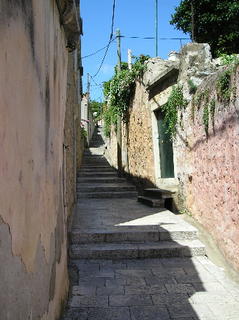

(Notice how there are more views looking UP the steps than DOWN the steps. That’s because after all the steps up, you really need to pause and rest.)
I was staying about 357 steps from the Old Town. That’s steps up (or down), not counting the flat parts. That works out to something like 22 flights of steps.
What really worried me was this sign I kept passing:
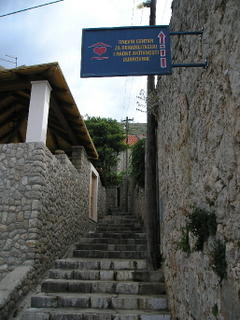
If you click the picture, you can see the words…something about ‘Rehabilitaciju’ and a nice heart next to it. You know, if you can actually make it up all those steps to the cardiac rehab place, I really don’t think you actually need the cardiac rehab place.
The cool thing about climbing (or descending) all those steps is that you pass along some interesting things.
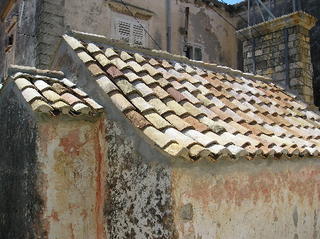
There are interesting tiles on this building.

It was interesting to pass this building each day…today it’s shirts and towels, yesterday it was sheets, the day before it was socks…
Eventually, though, I ended up just outside the Old Town at the Pile Gate.
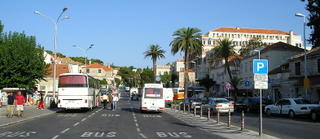
(Okay, actually, the Old Town is behind me, but there are more of those pictures later.)
Like I mentioned before, I’ve broken the pictures into smaller groups. Here are a few pictures, though, that don’t really fit into any of the other categories. Sorry.

You can’t go very far in Dubrovnik without seeing this guy. It’s (obviously) Sveti Vlaho. Okay, you may know him better at Saint Blaise. You know, the third century Armenian bishop who was martyred under the Roman governor Agricola. (Hey! I know that governor guy…he was in my high school Latin book!) Evidently, Agricola wasn’t too thrilled with Blaise…some accounts say that Blaise was flayed to death with hot iron combs. In this case, I believe ‘combs’ refers to those things that are used to comb wool, since St. Blaise is also the patron saint of woolcombers.
As an interesting aside, on St. Balise’s Day, February 3, people have their necks blessed by placing them in the cleft between two crossed candles. (Really. It happened to me while I was at Catholic school. Imagine me standing in Dubrovnik, reading the guidebook, looking at this guy, and saying, ‘Hey! I’ve heard of this guy…’) That’s because St. Blaise is said to have saved a child from choking on a fish bone. This all makes St. Blaise one of the Fourteen Holy Helpers, ‘ancillary saints believed to be efficacious at curing human ailments.’ St. Blaise is now patron saint of sore throats.
When not miraculously plucking pesky fish bones from the necks of children or watching over those woolcombers, St. Blaise is also the patron saint of Dubrovnik. Look closely at the picture…in his left hand, he holds the city of Dubrovnik. On his right shoulder, he has a pigeon. But that’s just coincidence.
Anyway, legend has it that in the 10th century, Dubrovnik defended herself from an attack by Venetian ships after St. Blaise appeared in a dream to Stoico, a local priest, and warned of the impending attack.
Bits of St. Blaise, including his head (or at least part of it), his arms, and his lower leg, now reside in the Dubrovnik Cathedral. They are paraded through the town on St. Blaise’s Day. (The parts are in richly decorated, expensive reliquaries, so I’m just trusting that his parts are actually in there.)
Whew! After all that talk of woolcombers and parading lower legs, it’s time to eat!
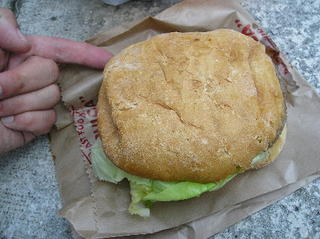
Here’s a hamburger. Yeah, exciting… But, if you zoom in to actual size, you’ll see that it’s huge! More than five and a half inches across (in metric, that’s…um…about two fortnights and a shilling, I think). But that’s not all!
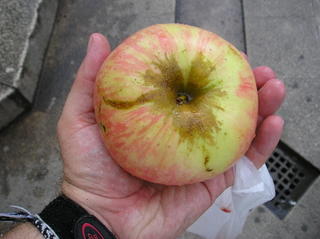
Here’s an apple. Yeah, exciting… But, if you zoom in to actual size, you’ll see that it’s huge! I ate and ate and ate until I could eat no more apple. And there was still more than one normal sized apple left.
Okay, after all that eating, let’s take a stroll to the new port. It’s rather pretty, particularly in the evening light.



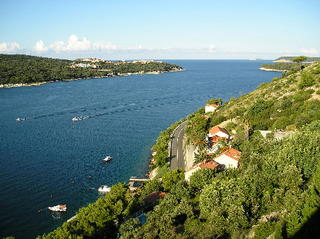


And, if you’re lucky, you can even go bungee jumping.
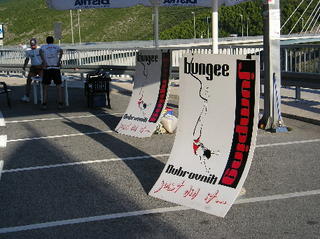
Really.

Look just to the left of the words ‘Bungee Cord’ – see that thing hanging down a bit? Yeah, that’s the bungee jumping cord. I can’t remember how high the bridge is, but if you look closely, you can see little tiny cars at the base of the bridge. It’s really a rather high bridge.
Old Town Dubrovnik

The old walls of Dubrovnik encircle a great deal of history. A UNESCO World Heritage Site, the Old Town can be entered through several gates.

By crossing a bridge, passing under a statue of St. Blaise, and then going through the narrow gates, visitors pass through the Pile Gate.

(The Pile Gate from the inside.)

At times, guards in traditional dress protect the gates to the Old Town.
One of the first things you encounter is the large Onofrian fountain, built in 1438 as the terminus of the city’s first main water supply.

The fountain has a number of free-flowing streams of cold, fresh water. One of the great things about the city is that there is always free water available. As hot as the city gets, it is always possible to keep your water bottles filled!

Directly in front of you is the Stradun, a 292-metre long street paved with highly polished stone and lined with shops and restaurants. To this day, most goods are delivered to these shops using traditional hand-carts.





At the far east end of the Stradun is a tall bell tower (and the small Onofrian fountain).
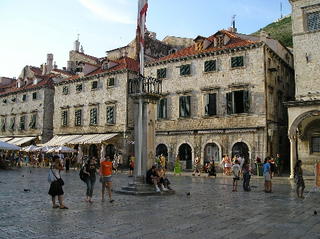
Just in front of the bell tower is the Orlando Column.
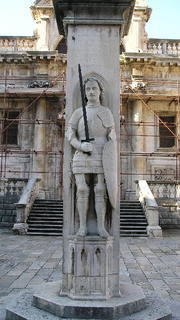
Paraphrasing from my guidebook, Orlando Furioso, Count of Brittany and Paladin of Charlemagne, was all that and a bag of chips. The book continues by saying that Orlando was, ‘eight feet tall, a flower of chivalry,’ and led a campaign to defend Dubrovnik against the Saracens in the 9th century. This statue was erected in 1418 and, in his hands Orlando holds his famous sword, Durandal. The original was supposedly indestructible and was said to contain in its hilt not only a thread from the Virgin’s cloak and one of St. Peter’s teeth, but also a hair from the head of St. Denis and a drop of St. Basil’s blood.
Just behind Orlando, collector of saintly biohazards, is the church of St. Blaise…

…topped with the ubiquitous statue of the Saint himself. He is flanked by Faith and Hope.

The first church was built here in 1348 (in thanks for the ending of the great plague), managed to survive the 1667 earthquake, burned in the 18th century, and was rebuilt in 1715.

The inside is rather Baroque. (I feel that sentence needs something else. Oh well.) Oh, here’s something…the alter faces south rather than east. This is because the city was getting crowded and there wasn’t much space left.

The Church of St. Blaise also has the body of St. Sylvan. (Yes, St. Blaise is in the Cathedral, St. Sylvan is in St. Blaise’s.) Anyway, he was brought here in 1847 from Rome. (Can you just imagine working in that office? ‘Let’s see…too many Saints here in Rome…let’s give one to Dubrovnik!’)
Just down from the Church of St. Blaise is the Cathedral.

As is generally the case with really old things, the original Cathedral is no more, having been destroyed in the 1667 earthquake. The current Cathedral is pretty new, dating only from 1713.


As I mentioned before, it houses bits of St. Blaise, only the old woman guarding the Treasury would not have been pleased if I had taken a photo.
Not too far from the Cathedral is the Rector’s Palace.
(Somehow I didn’t seem to get an outside picture of the Rector’s Palace. That’s okay…it looks a lot like the Sponza Palace here only bigger:)

It seems that the current Rector’s Palace isn’t the original. As is generally the case with palaces built too close to volatile gunpowder stores, it blew up. Twice. Finally, though, in 1464, they managed to build a structure that withstood not only gunpowder explosions but also the 1667 earthquake.

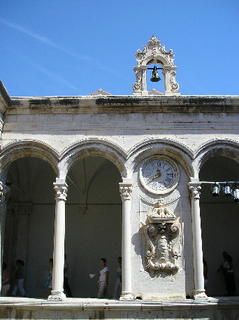
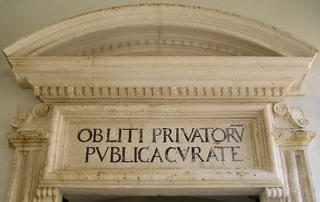
In addition to the main atrium and state apartments, the Palace also held courtrooms and dungeons.
You can also see some pretty sedan chairs.
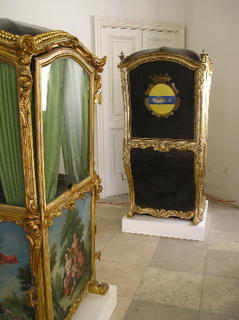
Remember how I mentioned the Sponza Palace earlier? (It looks a lot like the Rector’s Palace, only smaller.) That used to be the customs house and state mint.
Dubrovnik also was home to two monasteries – one Franciscan and one Dominican. I stopped by the Franciscan. Legend holds that it was built soon after St. Francis of Assisi visited Dubrovnik on the way to do whatever it was he had planned with the Saracens.
There is a rather nice medieval church.

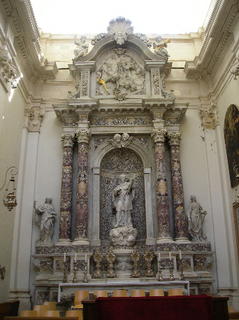
There is also a cloister with lovely plants.

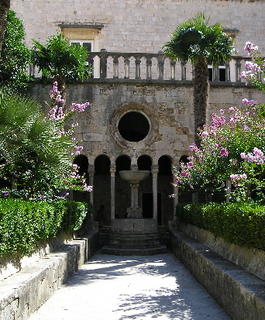


The friary also has Europe’s oldest continuing functioning pharmacy, started in 1317. Visitors can also see the hole left by Serbian mortar shells when the friary was bombed in December 1991.
There are several places in the Old Town where visitors can see a map like this one:

It is a map of damage caused during the 1991-1992 siege of the city. (You can click to see it larger so you can read the words.) Each symbol represents damage caused by the bombings. It is remarkable to see how far the city has come since then.
There’s a lot to buy in Dubrovnik. In addition to a plethora of souvenirs, you can also visit an outdoor market…

…buy some traditional handicrafts from the lace ladies…


…or even a CD of classical music.

These musicians were everywhere. (These specific ones.) Sometimes they were dressed in costumes, sometimes not, but their music provided a wonderful soundtrack to the city.
Before I forget, I have to show you this picture.
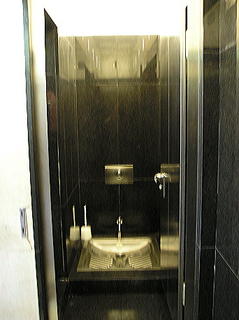
Sorry the picture is grainy…I took it in the bathroom.
The Old Town had one public toilet (that I know of). It was rather nice…marble walls, stainless steel fixtures, and no seat.
But now, just a few sights of the Old Town to finish this post.
The old harbor…




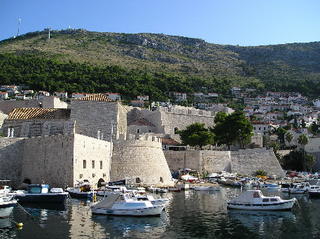

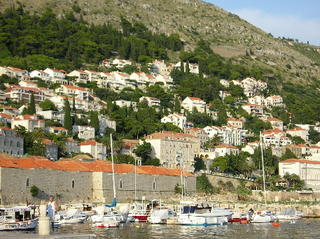

I love the narrow streets.
